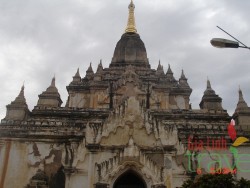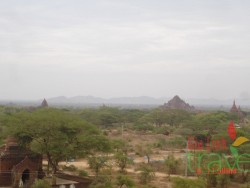History
History
History History Myanmar has a long, complicated and interesting history. Many peoples have lived in the region and the history began. The first identifiable civilization is that of the Mon. The Mon probably began migrating into the area in about 300 BC, and their first kingdom Suwarnabhumi, was founded around the port of Thaton in about 300 BC. The Pyu arrived in Myanmar in the 7th century and established city kingdoms at Binnaka, Mongamo, Sri Ksetra, and Halingyi. During this period, Myanmar was part of an overland trade route from China to India. By 849, the Burmans had founded a powerful kingdom centered on the city of Bagan and filled the void left by the Pyu. The kingdom grew in relative isolation until the reign of Anawrahta (1044 – 77) who successfully unified all of Myanmar by defeating the Mon city of Thaton in 1057. After the collapse of Bagan authority, Myanmar was divided once again. The Burmans had re-established themselves at the city of Ava by 1364, where Bagan culture was revived and a great age of Burmese literature ensued. The kingdom lacked easily defendable borders, however, and was overrun by the Shan in 1527. Surviors of the destruction of Inwa eventually established a new kingdom centered on Taungoo in 1531 led by Tabinshwehti (reigned 1531-50), who once again unified most of Myanmar. A popular Burmese leader named Alaungpaya drove the Bago forces out of northern Myanmar by 1753, and by 1759 he had once again conquered Pegu and southern Myanmar while also regaining control of Manipur. He established his capital at Rangoon, now known as Yangon. Myanmar was known to the West ever since western explorers had heard of it. Marko Polo was the earliest known westerner who discovered Myanmar and introduced to the West. There are seven states and seven divisions in Myanmar. States are named as below: The Mon are considered to be the first inhabitants of Myanmar possibly as early as 3,000 BC. The Mon people settled in central Myanmar and on down along the Bay of Bengal covering the eastern coast. Irrigation The Pagan Kingdom brought about the first unified state of Myanmar, through King Anawrahta (r 1044-1077). The state compared to a Hindu kingdom, with support coming from household taxes. By the thirteenth century though, Myanmar was starting to decline in part due to large amounts of money and time being spent on building pagodas. In 1287, Kublai Khan ransacked Pagan thus starting a period of continual conflicts that continued for many centuries. The appearance of Europeans had little effect on Myanmar due to their internal (and external) conflicts until they infringed on the Raj in Bengal. This brought about British occupation to keep peace on the borders of these countries and after 60 years, took over all of Myanmar. A positive result of this was that Myanmar became the world’s major exporter of rice. The downside is that there was also an influx of Chinese and Indian immigrants, who tended to exploit the Burmans. There was also slow social disintegration due to the British rule and it brought about a nationalist movement. The start of World War II was a time for political development among individuals. A student leader, U Aung San, put together the Burma Independent Army (BIA), a group who had been previously trained by the Japanese. In 1942, when the Japanese invaded Myanmar, the BIA joined the Japanese forces. Although they didn’t fight many battles, their numbers greatly increased eventually enabling them to overthrow the then weak Japanese government at the end of the war. By now they were known as the Anti-Fascist People’s Freedom League (AFPFL), with U Aung San still being the leader. After the war, the AFPFL talked with the British in an attempt to gain the independence of Myanmar and in April 1947 they won a majority of the constitutional assembly seats. Three months later, U Aung San’s political adversary U Saw had him, along with most of his cabinet, assassinated. Myanmar’s leader, as well as the AFPFL’s, during its early years of independence was U Nu, a former student leader and the foreign minister of Ba Maw. In 1962, an army takeover by General Ne Win, threw out U Nu’s government and put U Nu in prison for four years. General Ne Win’s idea was to turn Myanmar into a socialist country. This was called the “Burmese Path to Socialism” and only went downhill from there with everything, even retail stores, being nationalized. The economy Enough was enough and the people finally revolted after a devaluation of the currency, thus wiping out any monetary surplus people may have had. There were antigovernment riots and public letters criticizing Ne Win and declaring he needed to leave. He did eventually step down and retire in July 1988, but not until after the antigovernment riots in March and June of 1988. After Ne Win’s retirement, Myanmar had a few months of great turmoil. There were protests, looting, and a brutal police responses (the leader of the riot police was in change of the government) that led to up to a thousand people dead in Yangon, with thousands dead in other parts of the country. Maung Maung took charge and tried to appease those who resented the military rule and was successful in gaining a partnership with Brigadier Aung Gyi, General Tin U, and Daw Aung San Suu Kyi (the daughter of U Aung San). The armed forces appeared to side with this group thus causing the military to stage a coup against their government. In September of 1988, the Defense Minister (Genreal Saw Maung) declared the establishment of a State Law and Order Restoration Council (SLORC) that promised to re-establish law and order among other key items, but meeting the first item resulted in hundreds, possibly even over a thousand deaths. Daw Aung San Suu Kyi was awarded the Nobel Peace Prize in 1991, which brought great pressure on the SLORC. The SLORC had placed her under house arrest and General Tin U in prison in July 1989, since they were the leaders of the National League for Democracy (NLD). Although the NLD had won 80 percent of the seats and 60 percent of the votes, the SLORC retaliated by arresting a lot of them and declaring that a non-military government couldn’t In 1992, General Than Shwe took over as SLORC chairman, prime minister and minister of defense. Many political prisoners were released and Daw Aung San Suu Kyi was allowed visits from her family, with visits from a U.S congressman, a UN official and an American reporter two years later. Since she would not leave Myanmar (be exiled), she was detained for longer than the legal limit (which the government then changed). Finally, in August of 1995 she was released from house arrest and was permitted to stay in Yangon, where she conversed weekly with thousands of people, both citizens and foreigners outside her front gate. In 1993, the SLORC selected a national convention to start drafting a new constitution and told the convention to give the military a major government role. Obviously, since the convention was not being conducted democratically, the NLD party members walked out the convention and as of 1998, a new constitution had yet to be completed. In 1996, the SLORC increased tensions between the two groups (SLORC and NLD) by arresting over 200 members of NLD on their way to a part congress and doing it again in May 1997. In November 1997, the SLORC was disbanded and replaced with the State Peace and Development Council (SPDC), which still had the same leadership as the SLORC.


States
Divisions
Kachin
Yangon
Kayah
Mandalay
Kayin
Sagaing
Chin
Magwe
Mon
Bago
Rakhine
Ayeyarwaddy
Shan
Thanintharyi
systems were created and contacts, both cultural and commercial were established with India. In addition to keeping in contact with India, the Mon people had contact and influence upon their Mon neighbors in Siam (current day Thailand). As with the others who followed, the Monshad gone down the Irrawaddy River to set up their establishments. Following the Mons, were the Pyu, although they arrived much later in time. They started a capital in AD 628, near modern day Prome, but in the mid-ninth century, the arrival of the Burmans absorbed the communities of the Mon and Pyu people that were in their path.
quickly crumbled and as a result a very profitable black market evolved. Even when Ne Win turned over the presidency to San Yu, life didn’t improve for the populace. Some citizens lost their status with a ruling creating “associate citizens,” which were simply people whose ancestors weren’t from the “original” Myanmar races. Those targeted were the Sino-Burman and Indo-Burman communities and their rights included being able to vote, but they weren’t allowed to be elected or hold government positions above a certain level.
be established without a new constitution being written.
